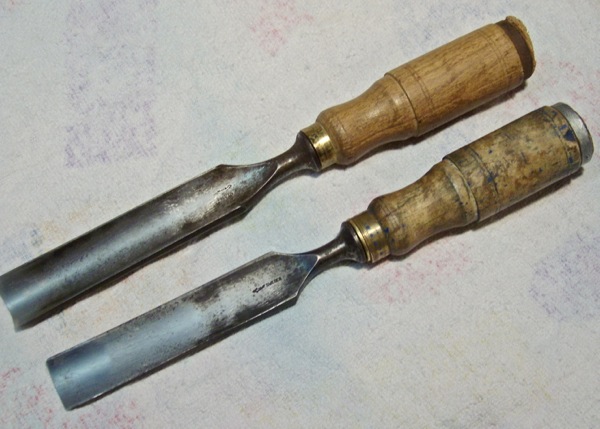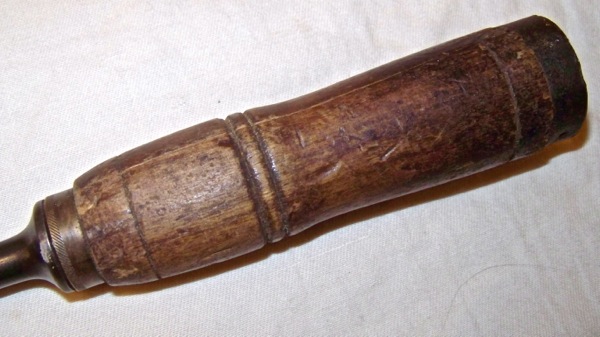Three Beech Handled Bergs
One of the great allures of collecting E. A. Berg chisels is the desire to finally have a set with perfect Masur Birch handles, preferably with intact, matching stickers. The problem is, if you ever actually use your chisels, they don’t stay looking new for very long! As of this writing, most of the Berg chisels with wooden handles have been around for more than 50 years. Unless you find tools that were never used, the wooden handles tend to be rather beaten up. In many instances, the original handle is long gone and has been replaced with an ill-fitting substitute or none at all. How many of us have found a chisel blade at a flea market or second-hand shop that has been used “sans handle” and now has a broken tang or an end socket mushroomed out of shape? When searching this type of venue (and we do, much to the distress of family members, especially when on vacation) and you find a Swedish chisel with the wooden handle intact, you have to consider yourself very lucky. After more than 30 years of collecting and dealing in Swedish chisels, one of the things I was pretty sure of was that Berg had only used Birch for their handles, never the softer Beech wood, unlike many of the second tier companies such as Solliden, Homestrand, Krona, and TecoMaster, to name but a few. But, as others have already said, Berg being Berg, you can never be sure what will turn up if you just keep looking.
 Three Beech Handled Bergs, photo 1.
Three Beech Handled Bergs, photo 1.
While contemplating and trying to catalog my overall collection of Swedish chisels I noticed something unusual about the three Berg chisels I will be discussing in this article. They are all old and I think they all have their original handles. Much to my surprise and completely out of character, they each have a Beech wood handle. I will discuss each of these tools separately.
The first chisel (the top one in both photo I and 2) is a very early Berg with a Beech handle. It’s probably a No. 1030 style firmer chisel, but notice how slight the edge bevels are. Upon closer inspection, it almost looks like the bevels were hand filed and forged to this pattern. The shape of the blade actually makes it closer in design to the No. 921 chisel illustrated in the reprint of the 1936 Berg catalog that I am lucky enough to possess. You can also see Berg catalog illustrations in the Galootopia post “Berg Chisels, Gouges & Handles”.
 The Top Berg Chisel has a Beech Handle, photo 2.
The Top Berg Chisel has a Beech Handle, photo 2.
This Beech handled chisel has a blade stamp (photo 3) that I call the “basking shark” which is a large species of shark found in Scandinavian waters and is one of the very earliest and crudest stamp versions that Berg ever used on their chisels.
 Basking Shark Blade Stamp, photo 3.
Basking Shark Blade Stamp, photo 3.
This Beech handle originally had a leather washer, now missing. This may have been the original handle supplied by Berg, since I have seen many different types of handles on early Berg chisels, including “London Pattern” style Boxwood and turned English Oak handles (middle chisel, photo 2). Also, notice how short the handle would have been- even if the original missing leather washer were still in place. It would have been a much shorter handle than we are accustomed to seeing on a typical Swedish tool (photo 4). The handle certainly is old, but is it an original Berg handle? It does not seem to correspond to any style of handle that Berg later illustrated in their catalogs as being available for purchase, so the question is, did Berg provide it or did the customer obtain the handle separately?
 Beech Handled Chisel, photo 4.
Beech Handled Chisel, photo 4.
 Close Up of Beech Chisel Handle, photo 5.
Close Up of Beech Chisel Handle, photo 5.
The thing is, the turning style of the handle, and especially the placement of the double ring pattern seems so similar to another very early Berg that I have, the second chisel in photo 2 and the top chisel in photo 6.
This second chisel has a different, but very early Berg stamp, which I refer to as the “dog fish”, (another shark species, much smaller than the aforementioned basking shark), as well as an English Oak handle that still has its’ leather washer intact. The brass ferrules for the two chisels are nearly identical. With so many similarities, I suspect that these are handles were manufactured by the Berg Company and provided with the chisels. The third chisel in photo 2 is another early “basking shark” with an old Birch handle that is more in line with what we expect a typical Berg handle to look like, except that the ferrule is a knurled steel ring, rather than the more familiar brass ferrule (close-up, bottom chisel in photo 6).
 A Dog Fish and Two Basking Sharks (Beech Handle is the Middle One), photo 6.
A Dog Fish and Two Basking Sharks (Beech Handle is the Middle One), photo 6.
Possibly the hammer ring is not the original, although it has certainly seen some wear. The beveled edges of this chisel are more typical of the finish detail one would expect from a Berg chisel (bottom chisel, photo 2). I suspect that Berg was just getting into the expansion of his business from cutlery and razors into chisels and other products when these tools were made, so variations in tool finish and handle design are to be expected, as they experimented with the best and most profitable method to produce these new lines of tools. They probably started out turning each chisel handle individually, so variations in size, style and material are understandable.
The second Beech handled chisel under consideration (the top one in photo 7) is a carving gouge, not as early in Berg’s production as the three chisels just mentioned but still made before the “modern shark” stamp was adopted in the mid 30’s. Two things mark this as an early era gouge- the style of the shark stamp, which I call a “droopy tail” (there were several variations of this general style of stamp) and also the fact that the stamp consists of two lines with the shark above the word Sweden (photo 9). Any two line stamp on a Berg gouge will also exhibit an older style of shark, for when they switched to the “modern shark” design they also moved the word Sweden into line beside the shark. This was a practical decision, since it would be much easier to clearly stamp one line, rather than two, into the curve of a gouge.
 Gouges – Beech Handle (top) and Masur Birch Handle (bottom), photo 7.
Gouges – Beech Handle (top) and Masur Birch Handle (bottom), photo 7.
 Close Up of Beech Gouge Handle, photo 8.
Close Up of Beech Gouge Handle, photo 8.
 “Droopy Tail” Blade Stamp, photo 9.
“Droopy Tail” Blade Stamp, photo 9.
The handle, which had split in two from use and was missing the ferrule when I got the tool, is identical in turning dimensions and detail to other Berg handles of the same size, so it must have been made on the Berg factory equipment. The only difference is the species of wood. How did a piece of Beech wood slip into a factory that only made Birch handles? I think I may have found a possible answer to this question and the third chisel under consideration helps to do that.
The bottom chisel in photo 1 is a rather special item; according to the EA Berg catalog from 1936 it is either a No. 920 firmer chisel, unbeveled or a No. 923 strong firmer chisel, all steel. The handle is a No. 958 handle.
 A Berg No. 920 Chisel with a Beech No. 958 Handle, photo 10.
A Berg No. 920 Chisel with a Beech No. 958 Handle, photo 10.
The interesting thing is, the illustration for the No. 958 handle shows it being made from a different wood than any of the other handles illustrated in the Berg catalog. The artist doing the engravings made a very good attempt to show the type of wood used for the different handles, using long, wavy parallel lines for the Plain Birch and dark squiggles to show the markings of the Masur Birch, but only the No. 958 handle is detailed with short, parallel striping, which I believe was intended to indicate these handles were made from Beech wood (see Galootopia post “Berg Chisels, Gouges and Handles” for illustration of No. 958 handle). So, this may be how Beech wood managed to get into the Berg factory and how my gouge ended up with a Beech handle, rather than the more typical Birch. Somebody probably just chucked the wrong piece of wood into the lathe and once it was turned, why not use it?
 Close up of the Beech Berg No. 958 Handle, photo 11.
Close up of the Beech Berg No. 958 Handle, photo 11.
I know that Berg switched to Birch for all their chisel handles at some point. Probably not a bad idea, since the handle for this chisel is also split in two from heavy use, only being held together by the hammer ring and ferrule. I’m not sure when the switch occurred, but a search of the handle illustrations in other, later editions of Berg catalogs, which I do not presently have, would possibly reveal this information. Unfortunately, the Berg catalog does not actually list the types of wood they used for the handles, so we have to go by the illustrations in the catalogs for any information beyond what were see in actual examples we can examine. I have a reprint of the 1927 Jernbolaget catalog, Berg’s biggest competitor, and it does list the wood species with each handle illustration and all of them were made from Birch, either plain or Masur. These old catalogs are invaluable sources of information about the types of tools being produced at that period. If any of our readers have access to other Swedish tool company publications or catalogs, we would really appreciate your sharing this information. After all, facts are so much better than conjecture!
Contributed by Randall Nelson
I recently bought an old wood lathe from an estate sale in Sweden. With it came a crate of old tools. Most if not all seem to be early berg chissels, gouges and woodturning tools. Some with new replacement handles but some with different what looks to be original handles. Not looking at all like yours. Many of them have only a shark looking stamp in the metal. I’d like to send some pictures, and would be grateful if anyone could tell me more about them.
David: I am not sure the best method for sharing pictures for this post, but if you get in touch with Birch, the host, I am sure he will inform you. It sounds like you may have gotten some very early material and I look forward to seeing it! Good luck!
Ok shure i’ll e-mail him directly.